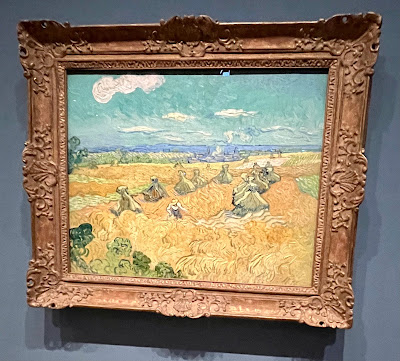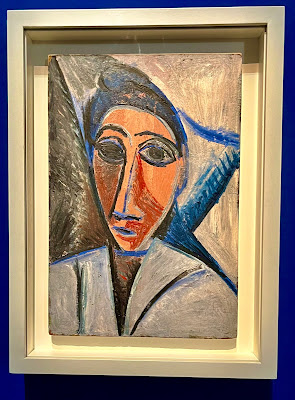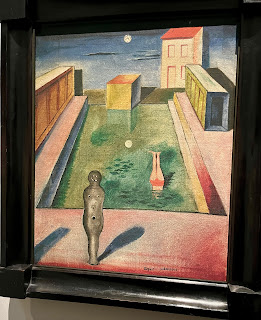We eagerly buy our copy every week, and browse the contents for the latest in everything, and in case we've overlooked something, a recap of "what's on".
Our newest discovery can be found in the highlighted small print on the left, under the list of abbreviations in the huge cinema section: "vfstf: version française, sous-titré en français". (French version, subtitled in French). Suddenly, the world of movies in French is open to us! Usually we avoid them because no matter how good our French, it's too hard to follow the rat-a-tat speed of movie dialog. But now, with several cinemas offering films with sous-titres en français once or twice a week, we can happily follow along! In the last ten days, we have three French movies under our belt, with many more to come.By far our most frequent destinations, though, are the large and small museums that offer so many outstanding exhibitions, it's hard to keep up with them.
We barely squeaked in to the show "Arresting Beauty" at the Jeu-de-Paume museum of photography. It was the final day, and we joined many others, anxious to follow the unusual and highly creative life of 19th century photographer, Julia Margaret Cameron. Born in 1815 in Kolkata, India, to a British civil servant father, and an aristocratic French mother, she was raised in France and India, married an Englishman in the colonial service, and on his retirement, moved to the Isle of Wight, England, where her next door neighbor was Alfred Lord Tennyson! At age 48, her daughter gave her a camera, and she immediately cleared out her chicken coop and turned it into a studio, then began photographing her family and people around her.
Cameron became known for her soft-focus, close-up portraits of men and women, as well as images depicting characters from mythology, Christianity and literature. Here, her niece, Mrs. Herbert Duckworth, sits for her picture as a 21-year-old newly-wed. I love how the deep shadows on her neck and the light on her face gives her a softly feminine and yet determined look. Widowed a few years after this photo was taken, Mrs. Duckworth remarried a Mr. Stephens, and gave birth to both Vanessa Bell and Virginia Woolf!Cameron used the collodion method of photography, whereby chemicals were poured onto a glass plate negative. The plate was then inserted into the camera, and the plate exposed for three to eight minutes. After exposure, the plate was removed and immediately developed in a darkroom.The results were sharper images than previous methods as well as the ability to pull multiple prints from the same negative, although working in almost complete darkness presented many hazards!
In a relatively brief but intense career, Julia Margaret Cameron produced a remarkable body of work. The Rosebud Garden of Girls, photographed in her neighbor Alfred Lord Tennyson's garden, refers to his poem Maud, and includes four sisters who were visiting the poet's home.
Many photos feature Cameron's personal maid, Mary Ann Hillier, seen here in this 1873 print, with her hair streaming in the pre-Raphaelite style...
...and here again in The Kiss of Peace.
Another niece, Rachel Gurney, wrote later "we never knew what Aunt Julia was going to do next". Here she is, as a youngster, clad in angel wings, looking wistful, perhaps wondering how much longer she must hold this pose! The photo is appropriately named I Wait!
Along with family, Julia Margaret Cameron photographed many distinguished figures of the day, including her neighbor, Alfred Lord Tennyson...
...Charles Darwin...
...and the Astronomer, John Herschel, who was an important influence on technique and practicalities of the medium. Cameron wrote him: "You were my first teacher and to you I owe all the first experience and insights."
The exhibition is called Arresting Beauty, perhaps because Julia Margaret Cameron wrote towards the end of her life "I longed to arrest all the beauty that came before me and at length the longing has been satisfied." She died at age 63 in 1879, whilst visiting her husband's plantations in then British Ceylon.
Meanwhile, over at the Musée d''Orsay, another exhibition was about to close: Van Gogh à Auvers-sur-Oise, chronicling the last two months of the painter's life. Leaving St.-Rémy in May, 1890, van Gogh moved to Auvers-sur-Oise, a community north-west of Paris, to be closer to his brother, Theo.
Along with joining his brother and several impressionist painter friends, the move also allowed him to be close to Dr. Paul Gachet, who specialized in the treatment of melancholia. In this painting, made in June 1890, Gachet is shown looking pretty melancholic himself, with a sprig of foxglove that he used medicinally. Van Gogh felt he was a kindred spirit: "His experience as a doctor must keep him balanced while fighting the nervous trouble from which he certainly seems to me to be suffering at least as seriously as I."
Even as he fought against his poor health, his unsteady mind, his relationship with his brother, and his place in the art world, during the two months van Gogh lived in Auvers-sur-Oise, he produced 74 paintings and 33 drawings in an incredible outburst of creativity. He completed one of his most well-known works, L'église d'Auvers-sur-Oise, in June, 1890.
July 8, 1890 saw this painting emerge: Champ de blé aux corbeaux, one of three on the same theme produced at the same time. Van Gogh wrote: "There are immense stretches of wheat under troubled skies and I have not shied away from trying to express sadness and extreme solitude." The departing crows seem to emphasize an emptiness.
Among the artist's final landscapes, this one caught my eye with its red, yellow, blue primary colors. You can almost feel his feverish agitation in the often contradictory flow of the brushstrokes.
At this point, I was feeling some "feverish agitation" myself. For some reason, the Musée d'Orsay does not appear to limit how many people to let into their exhibitions. We had booked tickets for a specific time, but we might as well have just shown up. At times it was so crowded we were five deep in front of a single painting!
I squeezed myself onto a corner of a bench, to take a breather, and focussed on studying what people were wearing on their feet.A few "clodhoppers", so popular two years ago, are still around...
...along with a crazy pair of pointed suede boots with what looked like skinny dowels for heels! How does anyone walk in these?!
These sneakers were much more my cup of tea. I was tempted to give up my seat on the bench to ask the woman where she bought them, but crowd density dissuaded me!Eventually, a gap appeared in the crowd, and I was able to return to these beautiful, final works of van Gogh. For a long time, this painting was thought to be from his Arles period, but the factory chimney and the church on the horizon place it in Auvers-sur-Oise. Champs de blé avec moissonnieur dates from mid-July, 1890Described as his "final sketch" and begun almost at the end of his time in Auvers, the unpainted sky and flat tints with no brushstrokes indicate that this work was never completed.
On July 27, 1890, Vincent van Gogh got up and set out with a canvas and paints, as he did every day. The result: Racines d'arbres (Tree Roots), a jumble of bright colors and wild abstract tangled shapes, perhaps a reflection of his increasingly tangled mind. Recently, researchers have pinpointed the exact spot where van Gogh spent the day working on this painting: the Rue Daubigny, a main road that runs through Auvers-sur-Oise The twisted, gnarled tree roots and stumps can still be seen in the slope of a hill there today, just 500 feet from the Auberge Ravoux, where van Gogh spent the last 70 days of his life. Painted on the same day as his suicide, the subject is charged with symbolism. "My life too is attacked at the very root" he wrote on July 10. Vincent van Gogh died on July 29, 1890, following a self-inflicted gunshot wound on 27 July. Racines d'arbres was his final painting.
The last stop on our recent museum circuit was to Le Petit Palais, where a vast, sprawling exhibition chronicles Le Paris de la Modernité 1905-1925. At this time, Paris was called "the international capital of the world", considered to be at the forefront of innovation, and a hub of tremendous cultural influence.
Artists such as Pablo Picasso came from all over, first taking up residence in Montmartre and later, when the Metro expanded its reach south, Montparnasse. In 1907, Picasso painted his famous Les Demoiselles d'Avignon, a major turning point in his work, although he did not exhibit it publicly for several years.. Some earlier studies for the final work includes this, titled Bust of a Woman or Sailor. The Cubist revolution had arrived!Before that, though, the Fauvists were causing scandals at the 1905 Salon d'Automne, where works by Matisse, Vlaminck and others exhibited what critics called "shapeless streaks". By 1907, Henri Rousseau's La Charmeuse de serpentes met with less resistance. A Black Eve is seen playing music in a primitive natural setting.By 1911, the Cubists were regular entries at the Salons d'Automne et Indépendants. Jean Metzinger's stunning L'Oiseau bleu was among the works receiving high praise from art critic André Salmon.
This painting by Gino Severini, La danse du pan-pan au Monico, heralded the arrival of the Futurists on the modern art scene. Their manifesto would horrify us today -- pro-war, anti-women! -- but their art was hugely successful. There's so much going on in this painting -- in the middle, a couple in red are dancing. Around them is a lively crowd, interspersed with waiters, gentlemen in formal evening wear, there's even a small cameo on the left side of an elegant woman in a fur collared coat climbing a sweeping staircase. It's also very large, taking up an entire wall of one of the galleries.
The exhibition is not all about art, though. Far from it. The next gallery revealed a full size Deperdussin Type B airplane, constructed in 1913! Built by the businessman Armand Deperdussin, with the help of engineer, Louis Bechereau, the plane exceeded the 200 km per hour mark for the first time.
Not to be outdone, this 1913 cute Peugeot, called Bébé Peugeot, designed by Ettore Bugatti, and the folding bicycle enjoyed great popular success, the car topping 60 km per hour!
The world of fashion took on the new century with a complete makeover. Thanks to designer Paul Poiret, women were encouraged to set aside their corsets and enjoy some freedom of movement...
...sleek lines, no bustles, we've never looked back!
Completed in 1913, the Théâtre Champs-Élysées was considered at the cutting edge of modernity, with reinforced concrete and innovative materials and technologies.However, the colorful costumes, inspired by Russian folklore, influenced both fashion and jewellry.
Cartoonists had a field day with The Rite of Spring. In this send-up, titled The Massacre of Spring, SEM depicts the Director of the Theatre dancing with Nijinsky in his Spirit of the Rose costume. Alongside, the racehorse Tango dances with his jockey, and librettist Coco dances in the arms of a monkey dressed as a woman.The outbreak of WWI turned the entire French population upside down. 72 million men were mobilized, and many experienced the horror of the trenches. The war also led to the introduction of illustrated magazines, like Le Miroir, whose covers and pages were filled with sensational, terrifying images of war -- a sharp contrast from the official imagery from the Army.Cultural life came to an abrupt halt at the outbreak of war, but slowly it began to emerge again as the war dragged on. Picasso showed his Demoiselles d'Avignon publicly for the first time in 1916, Modigliani exhibited at the Galerie Berthe Weil, and theatres, cinemas and public halls gradually reopened. For the ballet Parade at the Châtelet Theatre, Jean Cocteau brought together Eric Satie for the music, Léonide Massine for the choreography......and Pablo Picasso for the sets and costumes, here a wonderful horse...
...and here le Manager new-yorkais, complete with skyscrapers attached!
Jean Leprince's painting, Le Boulevard et la Porte de Saint-Denis 11 novembre 1918, captures the jubilant crowds filling the streets in celebration of the signing of the Armistice that ended WWI.
With the advent of this new-found peace, and with the ever great thirst for life, the "Roaring Twenties" barrelled into the Parisian consciousness.
"Flapper Girls" danced the charleston into the wee small hours, waving fans with ostrich feathers, drinking cocktails, wearing shoes of silver lamé...
...Josephine Baker (here painted by Kees van Dongen) took the city by storm, dancing the Charleston with jazz bands...
...Surrealist Max Ernst, with his 1919 Aquis submersus that recalled the metaphysical paintings of Giorgio De Chirico...
...and Fernand Léger's L'Homme à la pipe from 1920, perhaps a follow-on from his painting Soldier with a pipe that he made as a prisoner during the war.
The period of this exhibition culminated in 1925 with the opening (on 28 April 1925) of the International Exhibition of Decorative and Industrial Arts. Dedicated to art, decoration and modern life, the pavilions stretched from the Place de la Concorde to the Pont de l'Alma, and from the Champs d'Élysées roundabout to Les Invalides via the Alexandre III bridge! It brought together twenty-one nations, represented by 150 galleries and ephemeral pavilions, including the Grand Palais. Truly a symbol of Le Paris de la Modernité.
 | ||||
| Robert Delaunay Ville de Paris, la femme et la tour (1925) | |
À Bientôt!












































Enjoyed this as you must have had a wonderful time. Saw The Rites of Spring in
ReplyDeleteSF!
Wow!!! That was amazing thank you Fiona x
ReplyDeleteWhat a treat Janet!! On a stormy day in Inverness I get to accompany you on your amazing journey in Paris! Thank you!
ReplyDelete